Nikon FG - A Solid 35mm Film SLR Camera
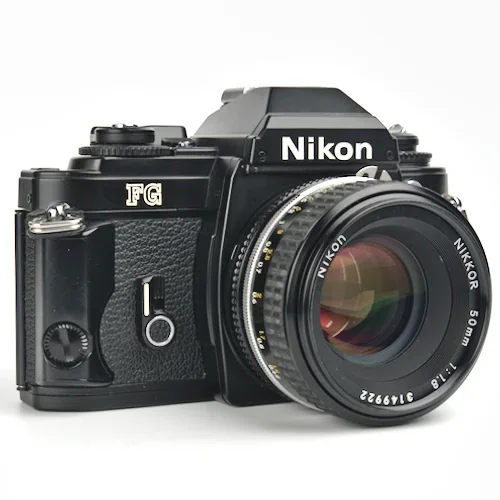
The Nikon FG was released in 1982 and manufactured until 1986. It is the first Nikon SLR with Programmed Auto-Exposure mode (AE).
It builds upon the Nikon EM. At the time this was to compete against the Canon AE-1 and Minolta X-700.
In 1985 the Nikon N2000 (F-301 in Europe) was introduced to replace the FG. Featuring a built-in motor drive for film advancement.
Price & Where to Buy
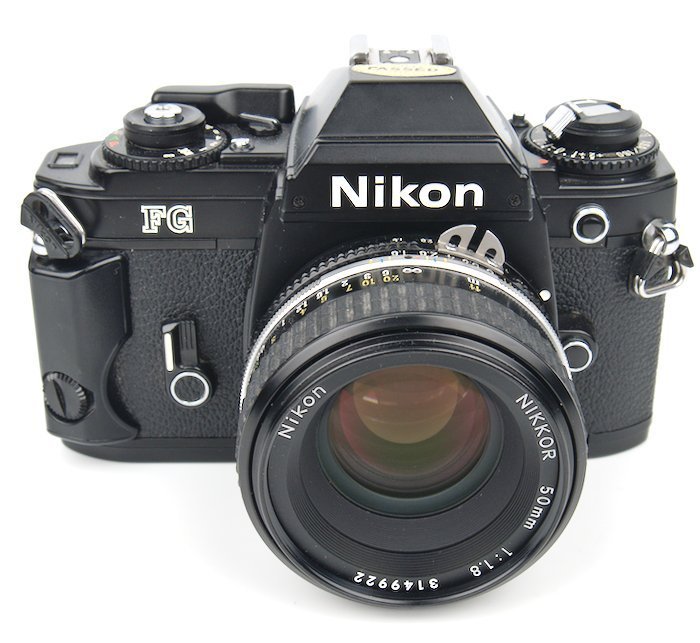
eBay generally has the largest selection of vintage cameras for sale. You’ll be able to have your choice of body only or the camera bundled with a lens.
Even if you want the Nikon FG paired with a 50mm f/1.8 Series E lens, you won’t have to spend very much.
Affiliate Advertising Disclosure
Outside the Shot is a participant in the Amazon Services LLC Associates Program, an affiliate advertising program designed to provide a means for sites to earn advertising fees by advertising and linking to Amazon.com.
As an eBay Partner, I may be compensated if you make a purchase. I also participate in affiliate advertising programs with KEH and Adorama. More can be found on the Affiliate Discolsure page.
See current price and more information on:
Nikon FG Battery - 2x LR44
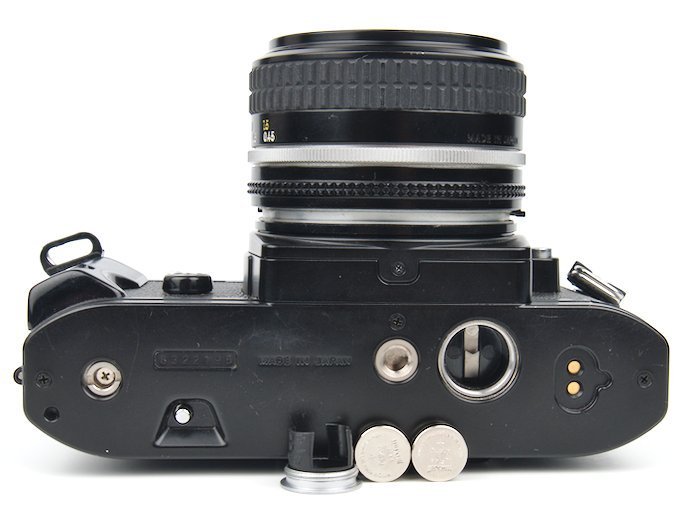
The Nikon FG uses two LR44 batteries. They are 1.5V each. These are easy to find in stores or online.
Batteries that have leaked can cause corrosion. They can also leave behind salts. Distilled white vinegar on a cotton swab will neutralize and remove the salts.
Without batteries, the camera can still function. You will be limited to the bulb and the M90 mode. None of the other speed settings will work.
The built-in exposure meter will also not work without power. That is because a micro computer is used to control those features.
M90 meaning a manual shutter with a 1/90 second shutter speed. Also, keep in mind that the light meter will not function without batteries.
With practice, I’m sure it is possible to learn to meter based on the sunny 16 rule. If the mechanical backup is something you want, just buy a fully mechanical camera where you’ll have access to the full range of shutter speeds.
Even with fresh batteries, you should still carry an extra set with you. Once you’re looking at needed 4 LR44 batteries, buying online will save enough money for a roll of film.
Original Price
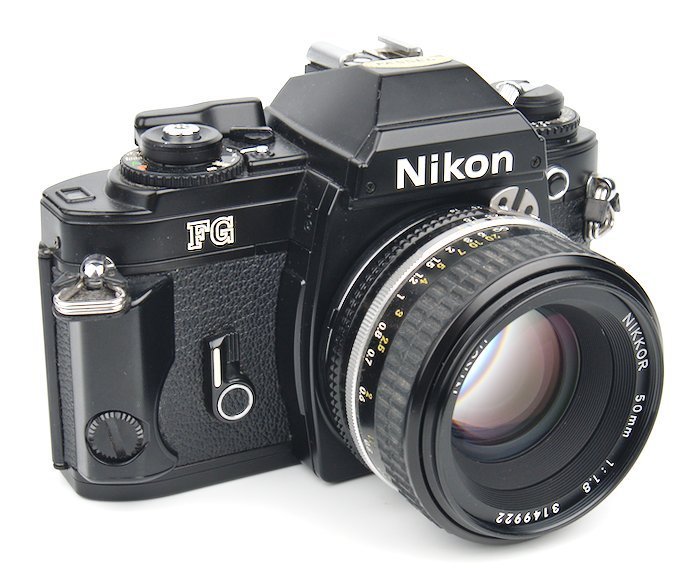
The Nikon FG had an original list price of $149.95 (w/ a $25 rebate applied), as seen in my Competitive Camera Corp Catalogue No. 24 from 1985. For $209.95 you could get the camera bundled with the Nikon 50mm f/1.8 Series E lens. Other kit lenses were available for purchase such the Nikkor 50mm f/1.4.
Adjusting for inflation, $149.95 is the equivalent of $407.22 today. $209.95 would be $570.16. At that price, it would be like buying a Nikon D5600 today.
Inflation was calculated using the BLS Inflation Calculator. The dates used were January 1982 to May 2019.
Build Quality
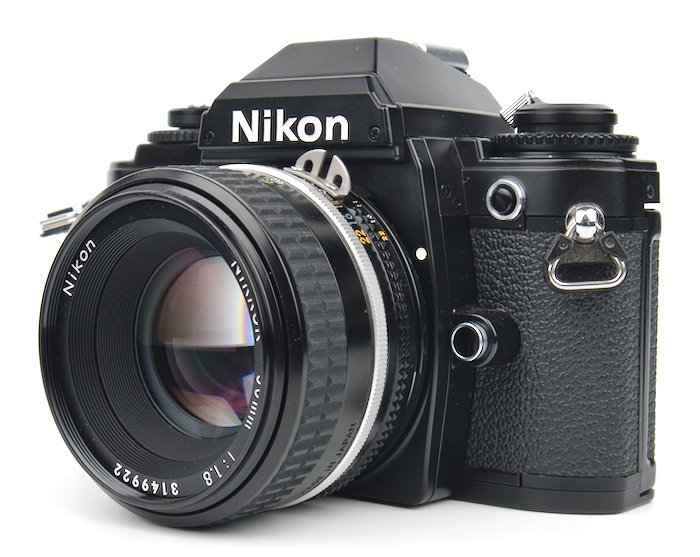
The camera was sold as an all black body and a chrome body.
The build quality of the Nikon FG is on par or slightly better than the Canon AE-1, or any of the later camera bodies that use similar designs.
A copper aluminum alloy was used for the camera chassis. While the exterior of the camera is polycarbonate.
I’m always impressed at the cool names plastics get. Though, the polycarbonate does feel better than cheap ABS plastic.
The quality difference compared to my Nikon FM2 is immediately noticeable. That is to be expected as the FM2 has a metal body, metal chassis, costed more when new, and still is more expensive.
Considering the price of the camera compared to the build quality, the overall value is acceptable. If copies of the FG were selling for over $100, I would have a bigger issue with the build quality.
Shutter Speed & Shooting Modes

The Nikon FG has an electronically controlled focal-plane shutter. Shutter speeds range from 1 second to 1/1000 of a second in full stop steps. There is a backup 1/90th of a second mechanical shutter.
The camera does not have a PC sync port, only a flash hot shoe. TTL flash metering is supported with compatible speedlights.
Automatic exposure modes:
- P - Programmed exposure mode
- A - Automatic exposure mode
In Program Auto Exposure (P) the Nikon FG selects a stepless shutter speed and stepless f/stop. The values are stored in a pre-arranged program for “perfect image exposure.”
Aperture priority (A) allows you to select the lens aperture on the FG, giving control over the depth of field. The FG’s microprocessor will then select the correct stepless shutter speed to give the best exposure possible.
The Nikon FG has a flash sync is 1/90 of a second. There is a hot shoe and flash ready light, but no PC sync port. More details on this can be found in the flash section below.
Also, there is a bulb mode and self timer with a 10-second delay. A cable release can be threaded into the shutter release button to control the bulb mode or to just trigger the shutter.
With the fastest speed being 1/1000 of a second, care needs to be taken choosing a film. It will be difficult to shoot with a wide aperture in direct sunlight with ISO 400 or faster film.
The narrow shutter speed range is a weakness. A higher-end camera would have a larger range. There is also no depth of field preview or mirror lock up.
The current film frame is shown through small window located to the right of the shutter speed dial.
Aperture Priority - Green “A”
Aperture priority mode leaves you in control over the aperture. When the shutter button is pressed the camera will decide on a shutter speed that it calculates to be correct for the scene.
An audio warning can be turned on to warn of camera shake. If the shutter speed would be too slow to hand hold, the camera would beep.
Switching to a wider aperture or using a tripod can reduce softness in images caused by camera shake.
Program Auto - Red “P”
To turn P mode on, the shutter speed dial to the red “P”. Then the lens on the camera needs to be set to the smallest aperture (Largest f-number). The final step is to turn on the audio warning with the small switch next to the shutter speed dial.
The audio warning will give a beep if there is a problem with the exposure. Otherwise, the camera will handle calculating the exposure for the image.
ASA/ISO Exposure Settings
Film ASA (same as ISO) can be set by pulling up on the outer ring of the exposure compensation dial. 35mm film speeds can be set from 12 - 3200 ASA in 1/3 stop increments.
There are higher end cameras that have a greater metering range.
The frame counter is to the right of the shutter release.
Loading Film
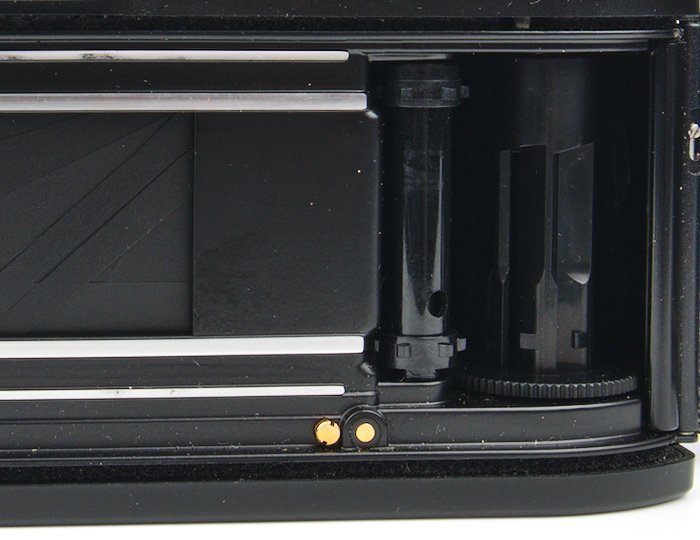
Loading film requires the film leader to be slotted into the Nikon FG’s take up spool. The film advance lever will turn clockwise if you are looking down on it from the rear of the camera.
The process of loading film isn’t great compared to Canon FD/EOS or later Nikon models.
Make sure you load film in shade or indoors. Direct sunlight can be bright enough to get through the light seal. This will cause light piping which will fog the first few frames of a roll of film.
To rewind film, the film rewind button on the bottom of the camera needs to be pressed, before the rewind knob will be allowed to turn.
Film to Use
I would suggest you shoot with a roll of 400 ISO speed film to start with. With 400 ISO, you’ll be less likely to end up in lighting situations that can be difficult to get good shots in.
Shooting with a fast lens in direct sunlight is going to be a problem with the 1/1000 of a second max shutter speed. If you are planning to spend time in direct sunlight, use a 100 ISO film.
Film availability and pricing is constantly changing which influences what the best film is.
Viewfinder
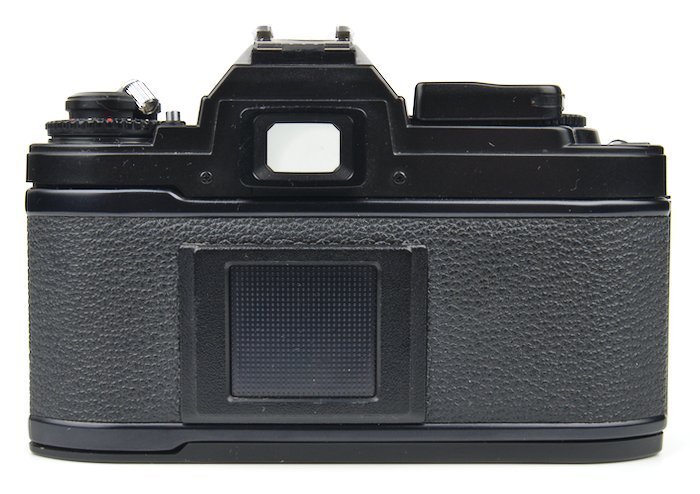
The camera uses the standard K focusing screen, found in many Nikon SLRs. The FG uses a split image rangefinder surrounded by microprisms.
This is my favorite type of focusing screen for manual focusing lenses. Manual metering is easy as the frame coverage is good with plenty of room to display light readings.
The pentaprism has a magnification of 0.84X. With a 50mm lens mounted on the camera, the viewfinder covers approximately 92% of the frame.
Metering & Exposure Control
Through The Lens (TTL) center-weighted metering is used. The sensor for the light meter is a sensitive silicon photodiode (SPD).
The outer edge of the center weighted metering area is shown in the viewfinder with a thin black circle.
The exact method used in the FG and FG-20 is called instant stop down metering. This method was lasted used on the N2020 (Nikon F-501).
The disadvantage of instant stop down metering is that the lens is fully stopped down before light readings are taken, and then the mirror flips up and the exposure can begin. This causes a relatively long delay from when the shutter released is pressed and when the exposure reading is taken.
There is an audio warning you can turn on to alert you to when a photo will be over or underexposed. I never turned this feature on because I don’t like the loud beeping noise.
There is also a button for AE backlight compensation. This button will overexpose an image by two stops. Doing this is helpful when your subject is backlit by a window or the sun.
The Nikon FG was the first consumer-level SLR camera with through-the-lens (TTL) off-the-film (OTF) electronic flash automation made by Nikon. The exposure metering technology in the FG was first used on the Nikon F3, which was a professional camera model.
Exposure Compensation (+2 to -2 EV)
Exposure compensation for program auto and aperture priority modes can be set with the inner dial that controls the ASA.
Compensation can be set from +2 to -2 EV in half-stop increments.
Nikon F-Mount Lens Selection
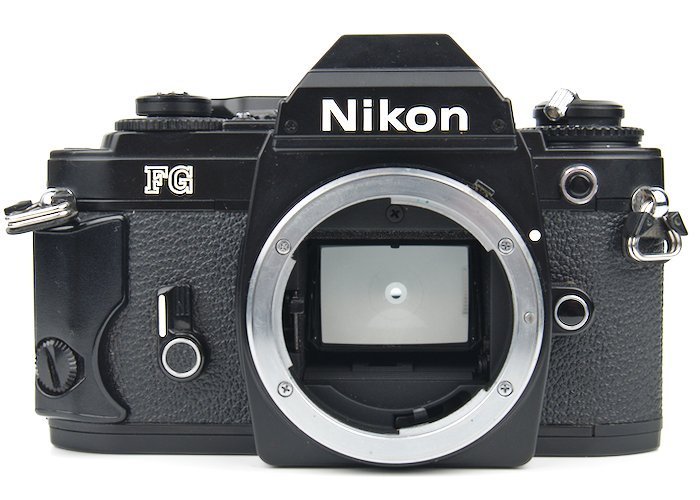
The Nikon FG uses the Nikon F-mount. Most F-mount lenses will work with the camera.
Lenses that are not compatible are Non-Ai and G Series lenses that rely on electronic control of the aperture. Non-Ai lenses will have meter coupling prongs sticking out and do not have tabs sticking back from the aperture ring.
Lenses that have the Nikon Nikkor branding are of higher quality than those without. They also cost more money. Be careful when buying vintage zoom Nikkor lenses as they are more likely to suffer from problems such as fungus or haze.
The Nikon Series E lenses are budget focused alternatives. They are small and compact but suffer from chromatic aberrations unless stopped down. However, that’s not an issue if you plan to use black & white film.
Camera Accessories
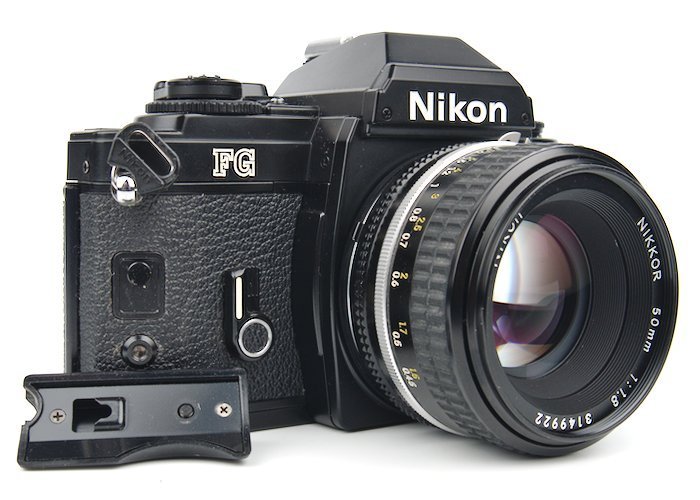
The MD-24 motor drive can sustain a maximum of 3.2 frames per second. It uses 4x AA batteries, making it heavy.
The Nikon SB-16A is compatible with TTL flash exposure control. The base is removable. A AS-9 coupler is required to use it in the hotshoe.
Camera Manual
Original FG camera manuals are for sale on eBay.
A scanned PDF copy of the Nikon FG manual can on found on Butkus.org.
Comparable Cameras
FG vs FG-20
Based on the same design, the Nikon FG-20 was meant to be a less expensive alternative to the FG.
The body is 50 grams lighter, but it does not have programmed auto exposure. The FG-20 retains manual exposure control and aperture priority modes.
FG vs FE
The Nikon FE was released in 1978 and is 100 grams heavier. It has aperture priority AE and manual mode, like the FG-20.
The build quality of the Nikon FE is better than the FG. There are also 3 different focusing screens that can be used in the camera. (K, B, and E)
FG vs Canon AE-1
The Canon AE-1 is more expensive on the used market and has a slightly lower quality build. What’s notable is that the AE-1 was the first automatic exposure camera to be released.
Due to design improvements, the Canon AE-1 Program is a better option because it is a more durable camera.